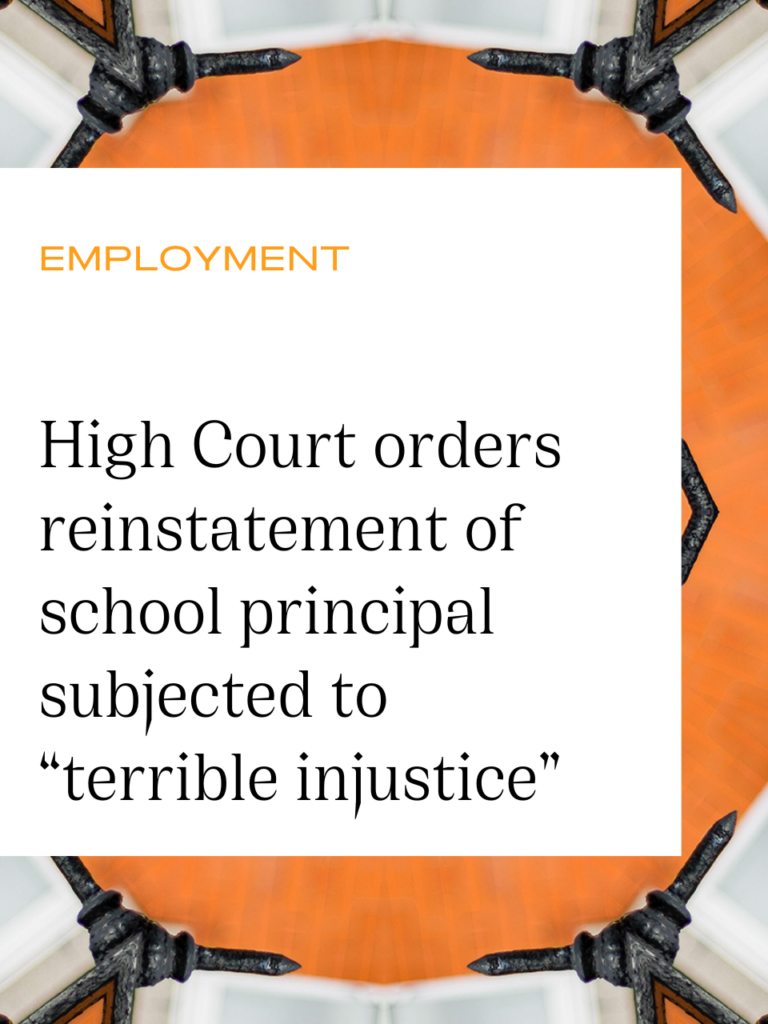
High Court orders reinstatement of school principal subjected to “terrible injustice”
A recent High Court decision has highlighted the significant importance of fair procedures throughout the disciplinary process.
In An Bord Banistíochta, Gaelscoil Moshíológ v the Labour Court1, the High Court ordered the reinstatement of a primary school principal who had suffered a “terrible injustice” at the hands of his employer following his “…odyssey through the school disciplinary process, the unfair dismissal process, and the legal system.”
The decision of Mr. Justice Cregan was highly critical of the actions and processes followed by the Board of Management and its Chair, as well as the delays experienced in progressing the subsequent unfair dismissal claim through the Workplace Relations Commission (“WRC”) and the Labour Court.
The case is a reminder to employers of the importance of applying fair procedures throughout any disciplinary process and, in particular, to be mindful of the risk that any prejudgment of the issues can taint the entire process.
Background
The Board of Management of Gaelscoil Moshíológ (the “Board”) appealed to the High Court the decision of the Labour Court, which had ordered the re-engagement of the school’s principal (the “Principal”) under the Unfair Dismissals Acts 1977-2015 (the “UD Acts”).
Child Incident – Administrative Leave (2012 – 2013)
The Principal’s suspension and ultimate dismissal were connected, in part, to a minor incident with a pupil in January 2012 (the “Child Incident”).Following the Child Incident, the Principal was placed on administrative leave pending a HSE investigation. That investigation concluded in November 2012 and found that the matter did not rise to the level of physical abuse. The HSE recommended the Board carry out its own investigation. The Chair however never completed this investigation into the Child Incident which, as a result, was never formally resolved.
Enrolment Issues and Suspension (2013)
However, an alternative investigation into alleged historic deficiencies in the enrolment figures in the school was commenced (the “Enrolment Issues”).
During this investigation, the Principal’s period of administrative leave was extended. He was subsequently suspended with pay in May 2013 pending the outcome of this investigation. The suspension letter set out allegations in relation to the Enrolment Issues as well as eight additional allegations against him (the “Additional Allegations”).
No further detail or substantiating evidence was ever provided in respect of the Additional Allegations throughout the investigation and disciplinary process.
Disciplinary Hearings and Dismissal (2014 – 2015)
The Chair and the Board held a number of disciplinary hearings throughout 2014 and 2015, with the Board resolving to dismiss the Principal with effect from 30 November 2015 based on the Enrolment Issues. A Disciplinary Appeal Panel (the “Appeal Panel”) rejected the Principal’s appeal.
WRC and Labour Court – Re-engagement
Both the WRC and the Labour Court upheld the Principal’s appeal under the UD Acts and ordered his re-engagement. The Labour Court ordered re-engagement from 1 September 2017. It held that the period from his dismissal in 2015 to the proposed date of re-engagement in 2017 was to be regarded as a period of unpaid suspension, therefore preserving his continuity of service.
High Court – Appeal on Point of Law
Under the UD Acts, a party can appeal a decision of the Labour Court on a point of law to the High Court.
Mr Justice Cregan carried out a detailed review of the evidence that was before the Labour Court to assess whether it was entitled, as a matter of fact and law to determine that the decisions of the Board and the Appeal Panel were unreasonable.
Procedural Issues
Under UD Acts regard should be had to reasonableness of the conduct of the employer and its compliance with the relevant procedures.
The procedures applicable to the Principal were set out in Circular 60/2009 “Towards 2016 – revised procedures for suspension and dismissal of principals” (the “Circular”) which are intended to comply with the general principal of natural justice.
Mr Justice Cregan in reviewing the actions of the Board found that there was an animus towards the Principal and criticised the Chair and the Board’s “disastrous and unreasonable misjudgements”. He had “no doubt” that at the time of the disciplinary hearing, they were “irrevocably biased against him and had prejudged the issue.”
The Court highlighted a significant number of procedural deficiencies in the disciplinary process along with the unreasonable conduct of the Chair and Board:
- There was a significant failure to complete the investigation into the Child Incident by January 2013 (or at all).
- The parents of the child at the centre of the Child Incident had written through solicitors to the Board advising that they considered the incident to be minor, that it had been fully resolved with the Principal and that its referral to the HSE was excessive. This letter was not shared with the Principal at the time, in what the Court agreed was “deliberate suppression and concealment of evidence”.
- The decision to keep the Principal on administrative leave in 2013 while the Chair began investigating the separate Enrolment Issues, was unreasonable.
- The inclusion of the Additional Allegations against the Principal without any further detail within a comprehensive report was unreasonable. It tainted the disciplinary process and was ‘hanging over’ the Principal throughout the process.
- The investigation of the Enrolment Issues was seriously deficient. The Board had failed to interview previous members of the Board who had been aware of the issues and had been actively involved in the enrolment and reporting of students.
- There had been a failure to adequately consider the evidence offered by the Principal which had shown there was confusion at the time concerning the reporting of enrolment figures and he had followed the common practice with the consent of the previous Board.
- The Board could not seek to introduce a zero-tolerance policy on the Enrolment Issues without any warning. This was “manifestly unfair and unreasonable”.
- The Board’s “grossly unreasonable delay” in dealing with matters meant the Principal was on administrative leave followed by suspension, for almost 4 years. This delay was “not only oppressive and prejudicial” to the Principal but caused enormous damage to his professional reputation, his standing in his community and his ability to defend himself before the Board and the Disciplinary Appeal Panel.
The Court held that the principles and procedures set out in the Circular had not been followed by the Board in their investigation and subsequent dismissal of the Principal:
“They exaggerated the charges, they suspended him without reasons, they ignored all the evidence he presented, they suppressed evidence and they never gave him a fair hearing.”
The High Court held that there was “overwhelming evidence” before the Labour Court to justify its decision that no reasonable Board of Management could have come to the decision to dismiss the Principal. In rejecting the Board’s appeal, the High Court was satisfied that the decision of the Board was not only “manifestly unreasonable” but also indefensible and entirely disproportionate.
Reinstatement
The Labour Court had previously ordered the re-engagement of the Principal from 1 September 2017.
The High Court went further and ordered reinstatement from 30 January 2013, this being the date on which the Court believed that his administrative leave should have ended. The extension of administrative leave and subsequent suspension were “manifestly unreasonable, a breach of his natural and constitutional rights and a breach of [the Circular].”
Reinstatement, unlike re-engagement, involves full preservation of the employee’s employment rights, including back-pay of salary and pension entitlements, along with continuity of service.
The High Court was clear that the Principal was entitled to have his name cleared, his reputation restored and to “walk back through the front gates of the school with his head held high” to resume his former position.
Delay – Potential Breach of the ECHR
Mr Justice Cregan was also critical of the delays within the appeals system. It had taken the parties six years to bring appeals in the WRC and the Labour Court. He questioned the efficacy of the Labour Court’s current process of scheduling intermittent hearings over a number of months, remarking that it would be more appropriate to schedule hearings over consecutive days.
While noting that it is a matter for the Labour Court to organise its own procedures, the Court warned that if it did not change this procedure, it ran a real risk of exposing the State to claims for damages for breach of Article 6 (the right to a fair and expeditious trial) of the European Convention on Human Rights (the “ECHR”).
It will be interesting to see if these comments will lead to a review and change of the Labour Court’s processes in due course.
Comment
The facts of this case are extraordinary, as is the level of criticism directed at the Chair and the Board in the judgment of Mr Justice Cregan. The case is a clear warning to employers of the high risks they can face under the UD Acts if those involved in the disciplinary process are determined at all costs to exit an employee from the business. An order of reinstatement not only has significant financial implications but can often give rise to considerable practical difficulties within an organisation.
This decision is under appeal to the Supreme Court.
The authors would like to thank Jack Lawlor, Trainee, for his assistance with this briefing.



